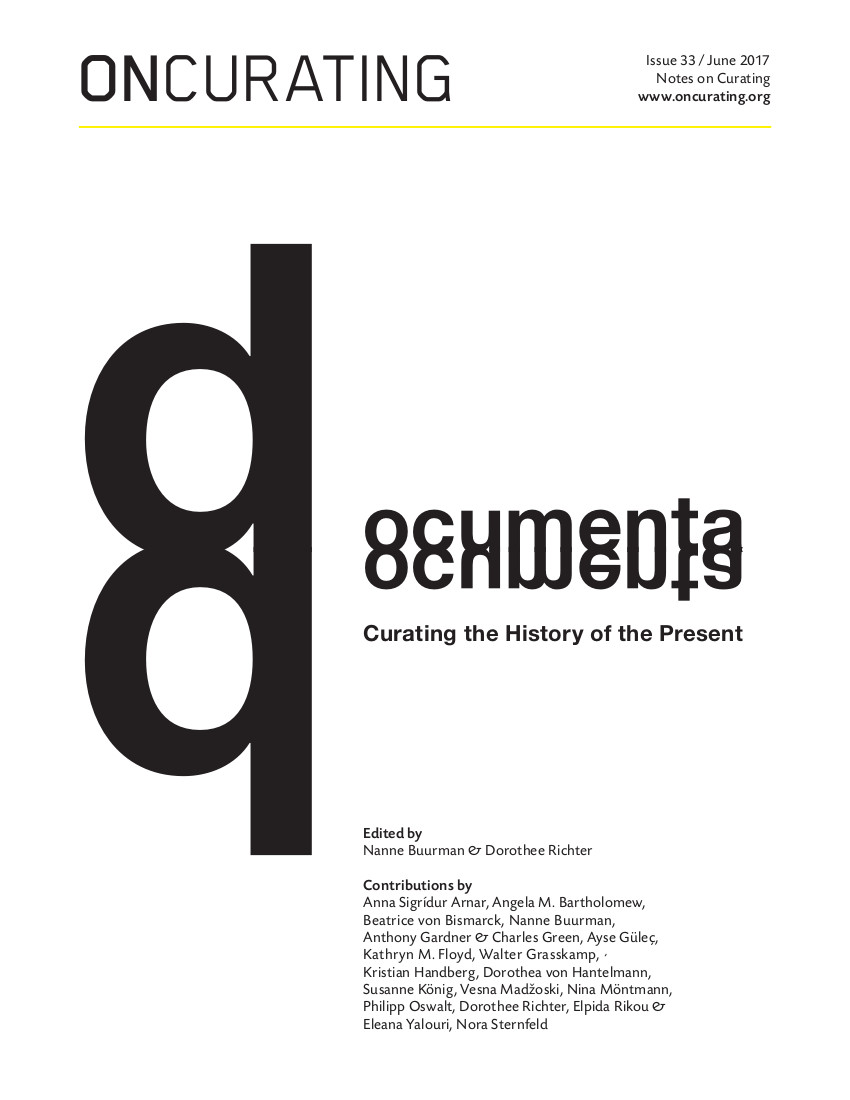OnCurating, 33: documenta. Curating the History of the Present (2017)
Filed under journal | Tags: · art, art history, contemporary art, curating, exhibition

“On the occasion of documenta’s 14th edition, this special issue scrutinizes the ways in which the Kassel-based periodic exhibition has been contributing to curating the history of the present since its inception in 1955. The authors engage with questions of how documenta’s iterations played a significant role not only in the making of a history of contemporary art but also in the canon of the relatively young field of curatorial and exhibition studies.”
Contributions by Anna Sigrídur Arnar, Angela M. Bartholomew, Beatrice von Bismarck, Nanne Buurman, Anthony Gardner & Charles Green, Ayse Güleç, Kathryn M. Floyd, Walter Grasskamp, Kristian Handberg, Dorothea von Hantelmann, Susanne König, Vesna Madžoski, Nina Möntmann, Philipp Oswalt, Dorothee Richter, Elpida Rikou & Eleana Yalouri, Nora Sternfeld.
Edited by Nanne Burmann and Dorothee Richter
Publisher OnCurating.org, Zürich, June 2017
Open access
171 pages
Forensic Architecture (ed.): Forensis: The Architecture of Public Truth (2014)
Filed under book | Tags: · aesthetics, architecture, art, forensics, image, law, politics, theory, war

“Forensics originated from the term ‘forensis’ which is Latin for ‘pertaining to the forum.’ The Roman forum was a multidimensional space of negotiation and truth-finding in which humans as well as objects participated in politics, law, and the economy. With the advent of modernity, forensics shifted to refer exclusively to the courts of law and to the use of medicine, and today as a science in service to the law. The present use of forensics, along with its popular representations have become increasingly central to the modes by which states police and govern their subjects.
By returning to forensis this book seeks to unlock forensics’ original potential as a political practice and reorient it. Inverting the direction of the forensic gaze it designates a field of action in which individuals and organizations detect and confront state violations.
The condition of forensis is one in which new technologies for mediating the “testimony” of material objects—bones, ruins, toxic substances, landscapes, and the contemporary medias in which they are captured and represented—are mobilized in order to engage with struggles for justice, systemic violence, and environmental transformations across the frontiers of contemporary conflict.
This book presents the work of the architects, artists, filmmakers, lawyers, and theorists who participated directly in the “Forensic Architecture” project in the Centre for Research Architecture at Goldsmiths University of London, as well as the work of associates and guests. It includes forensic investigations undertaken by the project and its collaborators aimed at producing new kinds of evidence for use by international prosecutorial teams, political organizations, NGOs, and the UN. It also brings together research and essays that situate contemporary forensic practices within broader political, historical, and aesthetic discourse.”
With contributions by Lawrence Abu Hamdan, Nabil Ahmed, Maayan Amir, Hisham Ashkar & Emily Dische-Becker, Ryan Bishop, Jacob Burns, Howard Caygill, Gabriel Cuéllar, Eitan Diamond, DAAR (Decolonizing Architecture Art Residency), Anselm Franke, Grupa Spomenik, Ayesha Hameed, Charles Heller, Helene Kazan, Thomas Keenan, Steffen Krämer, Adrian Lahoud, Armin Linke, Jonathan Littell, Modelling Kivalina, Model Court, Working Group Four Faces of Omarska, Gerald Nestler, Godofredo Pereira, Nicola Perugini, Alessandro Petti, Lorenzo Pezzani, Cesare P. Romano, Susan Schuppli, Francesco Sebregondi, Michael Sfard, Shela Sheikh, SITU Research, Caroline Sturdy Colls, John Palmesino & Ann Sofi Ronnskog / Territorial Agency, Paulo Tavares, Füsun Türetken, Robert Jan van Pelt, Srdjan Jovanovic Weiss / NAO, Eyal Weizman, Ines Weizman, Chris Woods.
Publisher Sternberg Press, Berlin, and Forensic Architecture, London, 2014
ISBN 9783956790119, 3956790111
744 pages
Reviews: Léopold Lambert (The New Inquiry, 2014), Martin Howse (Mute, 2014), Gaston Gordillo (Society and Space, 2015), John Beck (Radical Philosophy, 2015).
Exh. review: Harry Burke and Lucy Chinen (Rhizome, 2014).
Exhibition
Publisher
Publisher
WorldCat
PDF (22 MB, updated on 2021-1-6)
Comment (0)Laura Poitras, et al.: Astro Noise: A Survival Guide for Living Under Total Surveillance (2016)
Filed under book | Tags: · art, drones, free software, privacy, surveillance, technology, war on terror

“The filmmaker, artist, and journalist Laura Poitras has explored the themes of mass surveillance, “war on terror,” drone program, Guantánamo, and torture in her work for more than ten years. For this volume, Poitras has invited authors ranging from artists and novelists to technologists and academics to respond to the modern-day state of mass surveillance. Some contributors worked directly with Poitras and the archive of documents leaked by Snowden; others contributed fictional reinterpretations of spycraft. The result is a “how-to” guide for living in a society that collects extraordinary amounts of information on individuals. Questioning the role of surveillance and advocating for collective privacy are central tennets for Poitras, who has long engaged with and supported free-software technologists.”
Contributions by Ai Weiwei, Jacob Appelbaum, Lakhdar Boumediene, Kate Crawford, Alex Danchev, Cory Doctorow, Dave Eggers, Jill Magid, Trevor Paglen, Edward Snowden, and Hito Steyerl.
With an Introduction by Jay Sanders
Publisher Whitney Museum of American Art, New York, 2016
ISBN 9780300217650, 030021765X
241 pages
via i_d_rather_be_no_one
Review: Bernard E. Harcourt (Critical Inquiry).
PDF (17 MB)
Comment (0)
